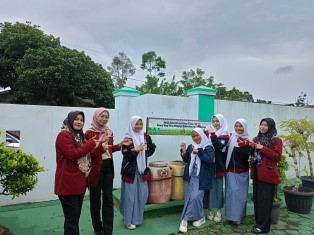Training and Assistance for Clean Living Patterns by Utilizing School Facilities at SMA Negeri 1 Liwa
DOI:
https://doi.org/10.70294/qsy19v08Keywords:
Cleane Lifestyle, School Facilitieas, Students Awareness.Abstract
Clean living patterns are an important aspect in creating a healthy and comfortable school environment. SMA Negeri 1 Liwa plays an active role in forming a clean and healthy young generation. This clean living pattern training and mentoring is intended to increase awareness of clean living behavior through the use of school facilities among SMA Negeri 1 Liwa students by collaborating between SMA Negeri 1 Liwa teachers and Muhammadiyah Kotabumi University Teaching Assistance students. Students act as facilitators and mentors in school cleanliness activities, such as waste management, optimization of school facilities, and education about the importance of clean living patterns guided by SMA Negeri 1 Liwa teachers starting from the data collection stage until the implementation process is complete, using qualitative descriptive methods. Optimal utilization of school facilities such as trash cans, sinks, and school cleanliness areas can increase students' awareness of the importance of maintaining environmental cleanliness. In addition, the ongoing cleanliness education program also has a positive impact on students' behavior in implementing clean living patterns. The findings show that student involvement in utilizing school facilities makes a significant contribution to the creation of a healthy school environment and supports the teaching and learning process.
Downloads
References
Bibliography
Larasati, N. (2020). Hubungan Antara Perilaku Hidup Bersih Dan Sehat (Phbs) Dengan Usaha Kesehatan Sekolah (Uks) Pada Siswa Sma Negeri Di Kota Surabaya. Jurnal Pendidikan Olahraga Dan Kesehatan, 8(1), 275–281.
Maharwati, N. K., & Dinatha, N. M. (2023). Strategi Kepala Sekolah Dalam Menerapkan Pendidikan Kesehatan Melalui Perilaku Hidup Bersih Dan Sehat Pada Anak Usia Dini. Jurnal Ilmiah Pendidikan Citra Bakti, 10(1), 57–69. https://doi.org/10.38048/jipcb.v10i1.1497
Noor, J. (2011). Metodologi Penelitian. Jakarta: Kencana. 1–23.
Nuha, A. A. (2021). Problematika Sampah dan Upaya Menjaga Kebersihan Lingkungan di Dusun Krajan Desa Randuagung Kecamatan Randuagung Kabupaten Lumajang. Khidmatuna : Jurnal Pengabdian Masyarakat, 1(2), 1. https://doi.org/10.54471/khidmatuna.v1i2.1011
Sya’diyah, H., Rachmawati, D. S., Widayanti, D. M., Kertapati, Y., Mayasari, A. C., Chabibah, N., Susanti, A., Amalia, N., & Alristina, A. D. (2021). Penyuluhan Kesehatan Perilaku Hidup Bersih dan Sehat Dalam Era Pandemi COVID-19 Di SMA Hang Tuah I Daerah Pesisir Surabaya Jawa Timur. Jurnal Pengabdian Kesehatan, 4(2), 185–197. https://jpk.jurnal.stikescendekiautamakudus.ac.id/index.php/jpk/article/view/140
Tentama, F. (2018). Penerapan Perilaku Hidup Bersih Dan Sehat (Phbs) Demi Kesejahteraan Masyarakat Kecamatan Tuntang Kabupaten Semarang Jawa Tengah. Jurnal Pemberdayaan: Publikasi Hasil Pengabdian Kepada Masyarakat, 1(1), 13. https://doi.org/10.12928/jp.v1i1.309
Yani, F. A., Hasibuan, H. A., & Dalimunthe, M. A. (2022). Pengetahuan Perilaku Hidup Bersih dan Sehat ( PHBS ) di SMA Negeri 1 Pancur Batu. Jurnal of Cahaya Mandalika, 2(1), 10–17.
Zulkhairi, Z., Arneliwati, A., & Nurchayati, S. (2019). Studi Deskriptif Kualitatif: Persepsi Remaja Terhadap Perilaku Menyimpang. Jurnal Ners Indonesia, 9(1), 145.








